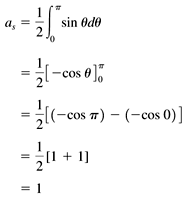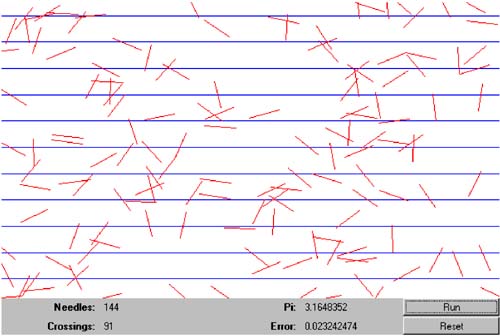14.5 Monte Carlo, Buffon s Needle, and p
14.5 Monte Carlo, Buffon's Needle, and p Besides being the name of a famous European gambling resort, Monte Carlo refers to a type of algorithm that uses random numbers to compute a desired value. [2] Monte Carlo algorithms can succeed when there are no simple computational formulas.
We'll examine a Monte Carlo algorithm for computing the value of p . In Chapter 13, we saw several elegant formulas for p that can compute hundreds of thousands, if not more, digits of p relatively efficiently . Our Monte Carlo algorithm does not do nearly as well, but it is fascinating, nevertheless. Here is how the algorithm, known as Buffon's needle, works. [3] Suppose you dropped needles , each of length 1, at random onto a sheet of paper ruled with parallel lines 1 unit apart. What is the probability that a needle crosses a line?
As shown in Figure 14-1, three uniformly distributed random values represent each needle. The first two random values are the x and y coordinates of the needle's midpoint , from which we measure the perpendicular distance d to the nearest line. The third random value is the needle's angle of rotation q about its midpoint. We can see that the needle crosses the line whenever Figure 14-1. A dropped Buffon needle of length 1 that crosses a line. The three uniformly distributed random values are the coordinates x and y of the needle's midpoint and its angle of rotation q . The value of d can range from 0 to Figure 14-2. The probability that a needle crosses a line is 2/ p , the ratio of the shaded area under the curve to the total area of the rectangle. The probability that a needle crosses a line is the ratio of the shaded area under the curve to the total area of the rectangle: Therefore, if we continue to drop needles, the ratio of the number of needles that cross a line to the total number of needles approaches Listing 14-3a shows class Needles , which represents the dropped needles. Method dropNext() uses the translation and rotation formulas we saw in Chapter 9. Listing 14-3a Class Needles . package numbercruncher.program14_3; import java.util.Random; /** * Implementation of Buffon's needles, which are randomly dropped * onto a ruled sheet of paper. */ class Needles { /** x coord of one end of a needle */ private float x1; /** x coord of the other end of a needle */ private float x2; /** y coord of one end of a needle */ private float y1; /** y coord of the other end of a needle */ private float y2; /** angle of rotation about the midpoint */ private float theta; /** paper's left edge */ private float xMin; /** paper's width */ private float xWidth; /** paper's bottom edge */ private float yMin; /** paper's height */ private float yHeight; /** count of dropped needles */ private int count; /** number that cross a line */ private int crossings; /** current computed value of pi */ private float pi; /** generator of uniformly-distributed random values */ private Random random = new Random(System.currentTimeMillis()); /** * Constructor. * @param xMin the paper's left edge * @param xMax the paper's right edge * @param yMin the paper's bottom edge * @param yMax the paper's top edge */ Needles(float xMin, float xMax, float yMin, float yMax) { this.xMin = xMin; this.xWidth = xMax - xMin; this.yMin = yMin; this.yHeight = yMax - yMin; } /** * Return the x coordinate of one end of the needle. * @return the coordinate */ float getX1() { return x1; } /** * Return the x coordinate of one end of the needle. * @return the coordinate */ float getX2() { return x2; } /** * Return the y coordinate of one end of the needle. * @return the coordinate */ float getY1() { return y1; } /** * Return the y coordinate of the other end of the needle. * @return the coordinate */ float getY2() { return y2; } /** * Return the count of all the dropped needles. * @return the count */ int getCount() { return count; } /** * Return the number of needles that crossed a line. * @return the number of crossings */ int getCrossings() { return crossings; } /** * Return the current computed value of pi * @return the value */ float getPi() { return pi = (2f*count)/crossings; } /** * Return the error of the current computed value of pi * @return the error */ float getError() { return pi - ((float) Math.PI); } /** * Initialize. */ void init() { count = crossings = 0; } /** * Drop the next needle. */ void dropNext() { ++count; // Compute random values for the x and y coordinates of the // needle's midpoint, and for the needle's angle of rotation. float xCenter = xWidth*random.nextFloat() + xMin; float yCenter = yHeight*random.nextFloat() + yMin; float theta = (float) Math.PI*random.nextFloat(); float sin = (float) Math.sin(theta); float cos = (float) Math.cos(theta); // Rotate about the origin a 1-unit length needle on // the x axis with endpoints at -0.5 and +0.5. x1 = -0.5f*cos; x2 = +0.5f*cos; y1 = -0.5f*(-sin); y2 = +0.5f*(-sin); // Translate the needle to its location. x1 += xCenter; x2 += xCenter; y1 += yCenter; y2 += yCenter; // Does the needle cross a line? if (Math.floor(y1) != Math.floor(y2)) ++crossings; } } Program 14 §C3 demonstrates the Buffon's needle algorithm. See Listing 14-3b. We see from the program's output that this is not really a good way to compute p ?ait converges very slowly and erratically. Listing 14-3b A demonstration of Buffon's needle algorithm. package numbercruncher.program14_3; import numbercruncher.mathutils.AlignRight; /** * PROGRAM 14-3: Buffon's Needle * * Demonstrate how we can calculate the value of pi using the * Monte Carlo technique and Buffon's needle algorithm. */ public class Buffon { private static final int MAX_NEEDLES = 10000000; // 10 million private static final int GROUP_SIZE = MAX_NEEDLES/20; /** * Main. * @param args the array of program arguments */ public static void main(String args[]) { Needles needles = new Needles(0, 0, 0, 10.5f); AlignRight ar = new AlignRight(); ar.print("Needles", 15); ar.print("Crossings", 15); ar.print("Pi", 15); ar.print("Error", 15); ar.underline(); do { // Drop a group of needles. for (int i = 0; i < GROUP_SIZE; ++i) needles.dropNext(); ar.print(needles.getCount(), 15); ar.print(needles.getCrossings(), 15); ar.print(needles.getPi(), 15); ar.print(needles.getError(), 15); ar.println(); } while (needles.getCount() < MAX_NEEDLES); } } Output: Needles Crossings Pi Error ------------------------------------------------------------ 500000 318282 3.1418679 2.7513504E-4 1000000 636433 3.1425147 9.2196465E-4 1500000 954980 3.141427 -1.6570091E-4 2000000 1273603 3.140696 -8.966923E-4 2500000 1591847 3.1410053 -5.874634E-4 3000000 1910364 3.1407628 -8.299351E-4 3500000 2229064 3.1403315 -0.0012612343 4000000 2547078 3.140854 -7.388592E-4 4500000 2865942 3.1403286 -0.0012640953 5000000 3184564 3.1401472 -0.0014455318 5500000 3502476 3.1406353 -9.57489E-4 6000000 3820892 3.1406279 -9.6488E-4 6500000 4139230 3.1406808 -9.1195107E-4 7000000 4457471 3.1407945 -7.982254E-4 7500000 4775901 3.1407685 -8.24213E-4 8000000 5093656 3.1411622 -4.3058395E-4 8500000 5411821 3.1412716 -3.2114983E-4 9000000 5730361 3.1411633 -4.2939186E-4 9500000 6048652 3.1411958 -3.9696693E-4 10000000 6366532 3.1414278 -1.6498566E-4 Screen 14-3 shows a screen shot of the interactive version of Program 14 §C3 in action. Screen 14-3. Buffon's needle algorithm in action. |
| |
| Top |
EAN: 2147483647
Pages: 141
- Using SQL Data Definition Language (DDL) to Create Data Tables and Other Database Objects
- Using SQL Data Manipulation Language (DML) to Insert and Manipulate Data Within SQL Tables
- Using Data Control Language (DCL) to Setup Database Security
- Writing External Applications to Query and Manipulate Database Data
- Working with Ms-sql Server Information Schema View





